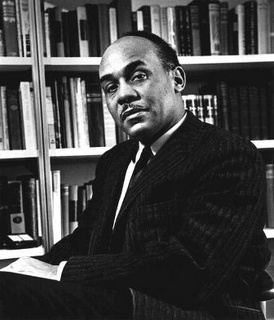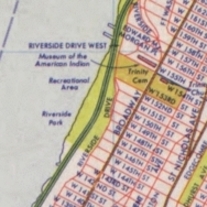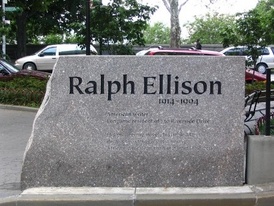Ralph Ellison
The Ralph Ellison Memorial at Riverside Park on 150th Street, Manhattan New York is not your typical African American landmark in New York City. Unlike the African Burial Ground or the Jackie Robinson Recreational Center, this memorial is not guarded by walls or cluttered with brochures and desks, ticket prices and tellers, student groups and security guards. The site, in contrast, is completely free and public. Located at the end of a one-way street between two busy roads and set within a collection of bustling Harlem apartment buildings and bodegas, the site offers a visual and atmospheric contrast; a place where New York urbanity meets the tranquil Hudson River.
Designed to celebrate the legacy of African American scholar and writer Ralph Waldo Ellison, the memorial is positioned directly across Ellison's last and permanent home at 730 Riverside drive and placed in Riverside Park where he was said to stroll and jive during his creative lifetime. Distinguished African American artist Elizabeth Catlett designed the sculpture commemorating Ellison, using a 15 foot high, 7 ½ foot wide piece of bronze to depict a cutout silhouette of a man. In interviews Catlett later explained, "I was thinking, he wrote the
Invisible Man
, so why don't I do an invisible man, since it was the idea of a positive and a negative shape, that's why I did it." Alongside the sculpture, a low-lying pink granite wall offers quotations from Ellison's writing and inscriptions of biographical details.
Today, the Ralph Ellison Memorial sheds significant historical light on the African American experience. The site houses an art piece that embodies the spirit of the Harlem Renaissance, a movement led by renowned black artists in the early 20th century who demanded racial equality and just liberation of black Americans on social, political, and economic levels through the production of art, music, and literature. Inspired by Ellison’s landmark 1947 novel,
Invisible Man
, the sculpture represents the struggles of confronting racist stereotypes and promoting social integration in America.
This entry contributed by a Columbia University student enrolled in Art History W3897, African American Art in the 20th and 21st Centuries, taught by Professor Kellie Jones in 2008.




